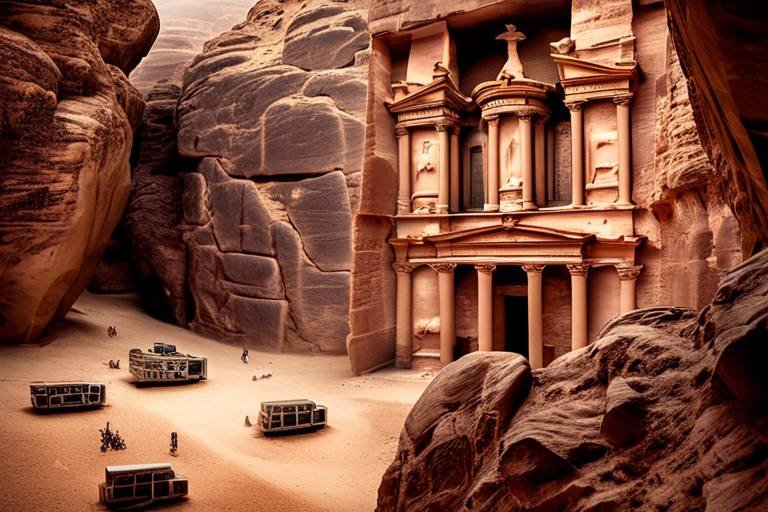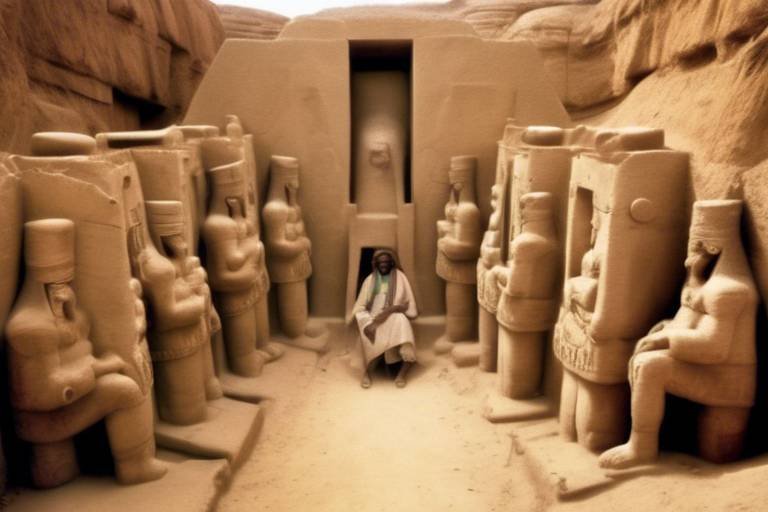The Secrets of the Lost Civilization of Sumer
The Secrets of the Lost Civilization of Sumer hold a captivating allure, shrouded in mystery and ancient wonders waiting to be unveiled. As we embark on a journey through the annals of history, we are greeted by the enigmatic civilization of Sumer, a cradle of innovation and culture that continues to intrigue scholars and enthusiasts alike.

Introduction to Sumer
The ancient civilization of Sumer, nestled in the fertile lands of Mesopotamia, holds a pivotal place in the annals of human history. Dating back to the 4th millennium BCE, Sumer is often regarded as one of the earliest known advanced civilizations, flourishing in the region of modern-day southern Iraq. The legacy of Sumer reverberates through time, offering a glimpse into a world of innovation, mystique, and ingenuity that continues to captivate scholars and historians alike.

City-States of Sumer
The city-states of Sumer were the building blocks of one of the earliest known civilizations in human history. These city-states, such as Ur, Uruk, and Eridu, were not just political entities but also centers of culture, religion, and innovation. Each city-state had its own ruler, known as a "lugal," who governed the city and its surrounding territories. The social structure of Sumer was hierarchical, with the ruling elite at the top, followed by priests, scribes, artisans, and farmers.
Religion played a central role in the lives of the people of Sumer, and each city-state had its own patron deity. The Sumerians believed that their gods controlled every aspect of life, from the weather to fertility, and they built impressive ziggurats as temples to honor and worship these deities. The priests held significant power and influence in Sumerian society, acting as intermediaries between the people and the gods.
Trade and commerce were vital to the prosperity of the city-states of Sumer. Located in the fertile region between the Tigris and Euphrates rivers, known as Mesopotamia, Sumer had access to valuable resources such as grain, timber, and metals. The Sumerians developed an extensive trade network, exchanging goods with neighboring regions such as Egypt, the Indus Valley, and Anatolia.
The city-states of Sumer were also known for their advanced agricultural techniques, including the use of irrigation systems to harness the power of the rivers for farming. The surplus food produced by Sumerian farmers allowed for the growth of urban centers and the development of specialized crafts and industries.
Overall, the city-states of Sumer were vibrant and complex societies that laid the foundation for many aspects of modern civilization. Their legacy lives on in the form of written language, legal codes, and architectural innovations that continue to influence the world today.

Sumerian Innovations
The Sumerian civilization was a hotbed of innovation, birthing groundbreaking advancements that laid the foundation for future societies to thrive. One of the most remarkable was the development of writing. Sumerians created the world's first known writing system, cuneiform, using wedge-shaped symbols on clay tablets. This monumental achievement revolutionized communication and record-keeping, enabling the preservation of knowledge and the dissemination of information.
Moreover, the Sumerians were pioneers in the field of mathematics. They introduced the concept of a numerical system based on the number 60, which is still reflected in our modern measurement of time and angles. Their mathematical innovations paved the way for complex calculations, geometric principles, and the development of early accounting systems.
In agriculture, the Sumerians implemented ingenious irrigation techniques to harness the power of the Tigris and Euphrates rivers, transforming arid lands into fertile fields. Their mastery of irrigation allowed for surplus food production, leading to population growth and the establishment of urban centers.
Architecturally, the Sumerians constructed monumental ziggurats, towering temple complexes that served as religious and administrative centers. These impressive structures showcased their engineering prowess and architectural ingenuity, setting a precedent for future construction projects.
The Sumerian civilization also made significant strides in the realm of arts and crafts. They excelled in pottery, metalwork, and textile production, creating intricate artifacts that reflected their cultural sophistication and artistic flair. Their artistic innovations influenced the aesthetics of subsequent civilizations in the region.
Furthermore, the Sumerians were early adopters of the wheel, a revolutionary invention that transformed transportation and trade. The wheel enabled the development of wheeled vehicles, such as carts and chariots, facilitating the movement of goods and people across vast distances.

Religion and Mythology
The ancient civilization of Sumer was deeply intertwined with a rich tapestry of . The Sumerians held a complex belief system that shaped their daily lives and societal structures. At the heart of Sumerian religion were the gods and goddesses who governed various aspects of the world. These deities were revered through elaborate rituals and offerings, seeking their favor and protection.
One of the most prominent figures in Sumerian mythology was Enki, the god of wisdom and fresh water, known for his role in creating humanity. Enki's counterpart, Inanna, the goddess of love and war, symbolized the dualities of life and held significant influence over fertility and the cycle of seasons.
The Sumerians believed in an afterlife where the souls of the deceased journeyed to the underworld ruled by Ereshkigal. This realm, known as Kur, was a place of judgment and eternal rest, reflecting the Sumerians' views on morality and the balance of life and death.
Mythological stories such as the Epic of Gilgamesh provided insights into Sumerian values, heroism, and the quest for immortality. Gilgamesh, a legendary king of Uruk, embarked on epic adventures and sought wisdom beyond mortal limits, showcasing the Sumerian fascination with the divine and the unknown.
Religious ceremonies and festivals played a vital role in Sumerian society, uniting communities and honoring the gods. The Ziggurat, a massive stepped temple, served as a sacred site for offerings and worship, symbolizing the connection between heaven and earth in Sumerian cosmology.
The intricate myths and religious practices of the Sumerians not only provided spiritual guidance but also reflected their cultural identity and worldview. By exploring the realms of the divine and the supernatural, the Sumerians sought to make sense of the mysteries of existence and the forces that governed their lives.

Trade and Commerce
Trade and commerce were the lifeblood of the ancient Sumerian civilization, fueling its prosperity and connecting it to distant lands. The city-states of Sumer, strategically located between the Tigris and Euphrates rivers, became bustling centers of economic activity, attracting merchants and traders from far and wide. Through a network of trade routes that spanned Mesopotamia and beyond, Sumerians engaged in the exchange of goods such as grains, textiles, metals, and precious stones.
The Sumerians were pioneers in developing a sophisticated system of commerce, utilizing clay tablets as records of transactions and inventing the world's first known form of writing, cuneiform, to facilitate trade agreements and contracts. This early form of documentation laid the foundation for future commercial practices and legal frameworks, demonstrating the Sumerians' advanced understanding of business and economic principles.
Moreover, the city-states of Sumer served as hubs for both domestic and international trade, attracting merchants from neighboring regions and fostering cultural exchange. The abundance of resources in Sumer, including fertile land for agriculture and access to waterways for transportation, made it an ideal location for commercial activities to flourish.
Trade in Sumer was not only about the exchange of goods but also played a crucial role in the dissemination of ideas, technologies, and cultural practices. As merchants traveled between cities, they brought with them new innovations in craftsmanship, agricultural techniques, and artistic styles, enriching the cultural tapestry of Sumerian society.
Furthermore, the economic prosperity generated by trade enabled the city-states of Sumer to invest in infrastructure development, such as irrigation systems, roads, and marketplaces, enhancing the efficiency of commercial operations and fostering urban growth. The vibrant marketplace in Sumerian cities buzzed with activity, offering a diverse array of products and services to meet the needs of a burgeoning population.
In essence, trade and commerce were integral components of the Sumerian civilization, driving its economic growth, cultural exchange, and technological advancements. The legacy of Sumerian trade practices continues to resonate in modern society, underscoring the enduring impact of this ancient civilization on the evolution of global commerce.

Decline of Sumer
As we delve into the history of the ancient civilization of Sumer, we must also confront the somber reality of its decline. The once flourishing city-states and innovative society faced a multitude of challenges that ultimately led to their downfall. One of the primary factors contributing to the decline of Sumer was the constant threat of invasions by neighboring empires seeking to expand their territories. The Sumerians found themselves in a perpetual state of conflict, weakening their defenses and draining valuable resources.
Environmental challenges also played a significant role in the decline of Sumer. The region faced periods of drought, flooding, and soil depletion, which severely impacted agricultural productivity, the backbone of Sumerian society. With food scarcity and resource depletion, the city-states struggled to sustain their populations and maintain stability.
Internal conflicts and power struggles further exacerbated the decline of Sumer. Rivalry between city-states, competition for resources, and political unrest within the ruling elite created a fractured society unable to unite against external threats. The once cohesive civilization began to fragment, losing its strength and unity in the face of mounting challenges.
As the once mighty civilization of Sumer weakened, its cities fell one by one, succumbing to the pressures of external invasions, environmental hardships, and internal divisions. The legacy of Sumer, with all its innovations and achievements, could not withstand the relentless forces that conspired to bring about its demise. The decline of Sumer stands as a cautionary tale of the fragility of even the most advanced societies when faced with insurmountable challenges.

Legacy of Sumer
The legacy of Sumer reverberates through the annals of history, leaving an indelible mark on the tapestry of human civilization. This ancient Mesopotamian society, with its innovative spirit and cultural achievements, laid the foundation for many aspects of modern life. From governance to literature, Sumer's influence can be seen in various facets of contemporary society.
One of the most enduring legacies of Sumer lies in its contributions to the development of written language. The Sumerians were among the first to create a writing system known as cuneiform, using wedge-shaped symbols on clay tablets. This revolutionary method of recording information paved the way for the preservation of knowledge and the dissemination of ideas, shaping the future of communication.
Furthermore, Sumer's legal system, characterized by its codified laws and principles of justice, has left an enduring impact on modern legal practices. The Code of Ur-Nammu, one of the earliest known legal codes, reflects the Sumerians' emphasis on fairness and accountability. Concepts such as property rights, contracts, and criminal justice originated in Sumer and continue to influence legal systems worldwide.
In the realm of governance, Sumer's city-states established administrative structures that laid the groundwork for organized societies. The concept of centralized authority, with appointed officials and councils overseeing various aspects of public life, set a precedent for future political systems. Sumerian rulers, such as the legendary Gilgamesh, embodied both the power and responsibility associated with leadership, shaping perceptions of kingship for generations to come.
Moreover, Sumer's literary legacy endures through epic tales such as the "Epic of Gilgamesh," considered one of the earliest works of literature. This epic poem, recounting the adventures of a heroic king in search of immortality, explores timeless themes of friendship, mortality, and the human condition. The enduring popularity of these narratives attests to the universal appeal of Sumerian storytelling.
Artistically, Sumerians excelled in various forms of expression, from intricate cylinder seals to monumental ziggurats. Their artistic endeavors not only showcased technical skill but also conveyed spiritual beliefs and societal values. The intricate designs and symbolic motifs found in Sumerian art continue to inspire contemporary artists and scholars, offering a window into the cultural richness of the ancient world.
Overall, the legacy of Sumer is a testament to the enduring impact of a civilization that thrived in the cradle of civilization. Its innovations in language, law, governance, and art have transcended time, influencing subsequent societies and shaping the course of human history. The echoes of Sumer resonate in the modern world, reminding us of the enduring legacy of a lost civilization.

Archaeological Discoveries
Archaeological discoveries in Sumer have unearthed a treasure trove of insights into this ancient civilization. Excavations at sites like Ur, Uruk, and Eridu have revealed intricate clay tablets inscribed with cuneiform script, providing a window into Sumerian writing and administrative practices. These texts document not only economic transactions and legal agreements but also mythological tales and religious rituals, offering a holistic view of Sumerian society.
Moreover, the architectural remains in Sumer showcase the advanced engineering skills of its inhabitants. The ziggurats, towering temple structures built in a step-like fashion, stand as enduring symbols of Sumerian religious devotion and architectural prowess. These monumental edifices not only served as sacred spaces for worship but also as administrative centers and astronomical observatories, reflecting the multifaceted nature of Sumerian culture.
Excavations have also uncovered artifacts such as intricate cylinder seals used for trade and administrative purposes, finely crafted jewelry adorned with precious stones, and intricately designed pottery depicting scenes from daily life. These artifacts not only highlight the artistic sophistication of the Sumerians but also provide valuable clues about their social customs, technological capabilities, and aesthetic preferences.
Furthermore, the discovery of the Royal Cemetery at Ur, with its elaborate tombs containing riches beyond imagination, sheds light on Sumerian burial practices and beliefs about the afterlife. The "Great Death Pit" at Ur, where the remains of Queen Puabi were found adorned with exquisite jewelry and ceremonial attire, offers a glimpse into the opulence and ritualistic traditions of Sumerian royalty.
Overall, the archaeological discoveries in Sumer continue to fascinate researchers and enthusiasts alike, offering a tantalizing glimpse into the rich tapestry of this ancient civilization and sparking further exploration into its enigmatic past.

The Enigma of Sumer
The enigma of Sumer continues to captivate historians, archaeologists, and enthusiasts alike, as the mysteries shrouding this ancient civilization remain largely unsolved. One of the most intriguing aspects of Sumer is the enigmatic disappearance of such an advanced society from the annals of history. How could a civilization with remarkable achievements in various fields simply vanish without a trace?
Speculations abound regarding the downfall of Sumer, with theories ranging from catastrophic environmental events to foreign invasions and internal strife tearing the once-prosperous city-states apart. The enigma lies in the lack of definitive evidence or consensus among scholars, leaving room for imagination and conjecture to fill the gaps in our understanding of this enigmatic culture.
Moreover, the enigmatic language of the Sumerians, known as cuneiform, adds another layer of mystery to their civilization. Deciphering the intricate symbols and texts has been a monumental task for researchers, unveiling snippets of their beliefs, daily life, and interactions but leaving much of their knowledge and wisdom hidden in the sands of time.
Exploring the artifacts unearthed from Sumerian sites only deepens the enigma, as intricate artworks, advanced tools, and sophisticated architectural remains hint at a society far ahead of its time. The question arises: how did a civilization so advanced for its era reach such heights of innovation and then fade into obscurity?
The enigma of Sumer invites us to ponder the complexities of ancient societies, the fragility of human accomplishments, and the enduring allure of the unknown. As we piece together fragments of their culture and history, we are reminded of the fleeting nature of civilizations and the enigmatic legacy they leave behind for us to unravel.
Frequently Asked Questions
- What is the significance of the Sumerian civilization?
The Sumerian civilization holds immense significance in history as one of the earliest known civilizations to develop in Mesopotamia. It is credited with numerous innovations in writing, mathematics, and governance that laid the foundation for future societies.
- What were the major contributions of the Sumerians to human development?
The Sumerians made significant contributions to human development, including the invention of writing using cuneiform script, the development of the wheel, advancements in agriculture such as irrigation techniques, and the establishment of complex city-states with sophisticated social structures.
- How did religion play a role in Sumerian society?
Religion was a central aspect of Sumerian society, with the belief in multiple deities governing various aspects of life. The Sumerians built ziggurats as religious centers, conducted rituals, and worshipped gods and goddesses such as Inanna, Enlil, and Utu.
- What led to the decline of the Sumerian civilization?
The decline of Sumer was influenced by factors such as invasions by neighboring peoples, environmental changes like droughts and floods, internal conflicts among city-states, and the shifting of power to other emerging civilizations in the region.
- How has the legacy of Sumer impacted modern society?
The legacy of Sumer can be seen in various aspects of modern society, including the use of the 60-minute hour and 60-second minute, the legal concept of precedent, architectural innovations like the arch, and the influence of Sumerian myths and stories on later cultures.



















